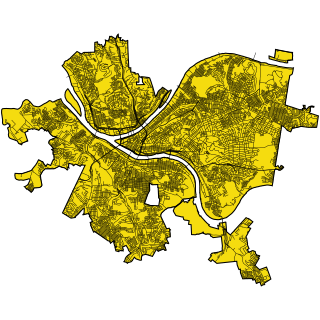Notes:Book Way
1834-02-04: Source:Wood-street-property: "a 10 feet alley recently laid out by the widow and heirs of Jeremiah Sturgeon, dec'd."
1852: Source:Mcgowin-1852: Unlabeled, from Diamond Alley to Virgin Alley, slightly offset at Fifth Street
1868-10-26: Source:Municipal-record-1868, Select Council: "Also a petition for a gas-lamp at the east end of Bank alley, corner of Virgin alley."
1872: Source:Hopkins-1872: Unlabeled, from Virgin Alley to Diamond Street
1873-07-01: Source:Valuable-property mentions Sturgeon Alley.
1873-12-30: Source:Street-nomenclature: "Bank alley, Fifth avenue to Virgin alley, Book alley." Also Source:Ordinances-relative-to-street-improvements.
1881: Source:Ordinance-1880-1881-33
- "Book alley, from Fifth avenue to Strawberry alley [?!], Third ward."
- "Sturgeon alley, from Diamond street to Fifth avenue, Third ward."
1882: Source:Hopkins-1882, plate 1: plan "Hrs. of Jer. Sturgeon"
1889-01-07: Source:Highest-pittsburg-valuations: "Below Wood Street ¶ we have upon the right the most beautiful iron building in the city—that of the First National Bank. Back of it, and indeed on both sides of Fifth avenue, will be seen upon the map alleys almost opposite one another, and yet of different names and different widths. It is doubtful whether the nomenclature of these two little passages is familiar to the general reader even though he may know that such apertures exist. Book alley is not mentionable as being memorable in any way, and the naming of it is only to be conjectured in that the Post printing office stood in place of the bank for many years. Sturgeon alley is familiar to those bibulously inclined for Charley Spencer's gilded saloon and ante and upper rooms. It was for a long time a favorite resort because, not only of its elegant furnishment and supplies of 'the best the market affords,' but for the fact that gentlemen could drop in there from the most prominent thoroughfare of the city with little if any observation. Judge Ewing squelched the place on the first heat under the Brooks law."
1890 layer: Book Alley, Fifth Avenue to Virgin Alley; Sturgeon Alley, Diamond Street to Fifth Avenue
1898-03-03: Source:Narrow-thoroughfare
1910-03-31: Source:Ordinance-1909-1910-715 made Sturgeon Alley part of Book Alley
1915-05-22: Source:Hamilton about Jeremiah Sturgeon
1934-05-17: Charles F. Danver, Pittsburghesque, Pittsburgh Post-Gazette, p. 6: "Book way, between Fifth avenue and Diamond street (just below Wood) was once known as Piatt's way. . . . It was so-called because it led the politicians of those days to the side door of Piatt's cafe, on the corner, which later, under the late Bongiovanni, became Pittsburgh's first cabaret. . . ."
1937-10-22: Charles F. Danver, Pittsburghesque, Pittsburgh Post-Gazette, p. 10 (Newspapers.com 88923224)
"Piatt's Alley."
Fifth avenue's shop fronts, on the lefthand side just below Wood street, are cleft by a dingy crevice designated in the city directory as a part of Book way, but known to oldtimers as "Piatt's alley." It is so called because it led to the side entrance of Piatt's Cafe, a favorite hangout of political big shots about 25 years ago.
Two former Pittsburgh mayors used the entrance on occasion. Also a famous party boss and many lesser caliphs. The bar on the first floor was operated by the late James Piatt, a witty Irishman well remembered as a capable host. The dining-room upstairs was at different times run by the late Frank Bongiovanni and Alfonse Negri.
Now a shabby crack in the wall, "Piatt's alley" figured in shaping the political destinies of many well-knowns of that day. The cafe cloaked important secret confabs. And Joe Hiller, of the Rialto, asserts that the upstairs dining-room was the birthplace of the town's night club business.
The cafes at that time were without entertainment, but Joe, then managing Shapira's music store on the corner, sold Mr. Piatt the idea of letting his piano player and a song plugger put on a show. They were Leo Marx, now Chico of the famous Marx Brothers, and Arthur Gordini, who later worked up to a seat in the New York stock exchange. They passed the hat and collected $11.
Newsies, shop girls and toilers in neighboring office buildings are now the chief frequenters of the narrow byway, using it as a shortcut between Fifth avenue and Diamond street. At night it is sometimes haunted by furtive tatterdemalions picking at the cans of leavings set out by the food markets at the close of the day.
1948-11-18: Charles F. Danver, Pittsburghesque, Pittsburgh Post-Gazette, Daily Magazine, [p. 4] (Newspapers.com 89741355): "AFTER 35 years in the Granite building the Presbyterian book store has moved to Oliver avenue and—Book way. . . . Oddly enough, Manager Richard W. Gibson didn't know it was called Book way until he signed the lease. . . . He has just put up a sign reading "Book Alley." . . ."
1952-06-03: Source:Speer-1952-06-03: "In many cases a new pole is going in, at the same time as the new sign. ¶ We noted the one at Book Way, off Oliver Ave., downtown, but the passageway is not so named because the Presbyterian Book Store is there. Long before that store, in fact on an 1840 city map, there was a 'Book Way' listed." — This claim seems dubious.
1960-06-05: Source:Books-books-everywhere: "How or why it was called Book (Alley or Way) in the first place is unknown, but it was the previous site of the old Pittsburgh Press Bldg. It is purely coincidental that Book Alley or Book Way is the present site of the Presbyterian Book Store which moved there in 1950."
1967-03-27: Source:Ordinance-1967-120 vacated Book Way from Fifth Avenue to Oliver Avenue
Bank history
1888: Source:Allegheny-hundred, pp. 258–259
1906: Source:Killikelly, pp. 264–265
1922: Source:History-pgh-environs-2, pp. 295–296, 311
1959-11-22: Source:Swetnam-bank
1968-05-13: Vince Gagetta, "5th Ave. bank razing marks end of era and sets record," Pittsburgh Post-Gazette, [p. 29] (Newspapers.com 88232696): some history of the Pittsburgh National Bank (predecessor of PNC) and the First National Bank Building built in 1908/1912.
